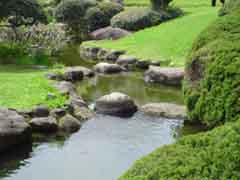|
Edge Stones

Erosion occurs wherever water and soil meet in the natural landscape. The soil is washed away, leaving exposed rock at the edges of rivers, lakes, and oceans. Whereas nearly every Japanese garden features some form of water, each garden also must attempt to evoke the natural pattern of exposed rock at the water's edge.
Known as gogan-ishigumi in Japanese, waterside edge rocks serve two basic purposes: (1) They prevent erosion, and (2) They look attractive. JOJG publishes regular articles about gogan edge stones. These articles discuss everything from the aesthetics of mastering the complicated gogan pattern to the important concrete engineering that is installed behind the edge rocks.
A few JOJG edge stone articles are presented here:
----------------------------------------------------
THE NECKLACE EFFECT This article talks about how NOT to install the edge stones around your pond.
WATERCOURSE GATE STONES This JOJG article explains how natural stream courses tend to flow through "gates." The article discusses how to employ watercourse gate stones in your home garden.
MASTERING THE GOGAN PATTERN Executing the 3-D gogan zig-zag is more difficult than it looks. This article discusses the aesthetics of the gogan pattern and how to construct it.
SUCCESSFUL POND EDGING A successful pond displays more than one type of edging. This article explains the various styles including several stone edging techniques.
USING PLANTS TO SOFTEN ROCKS Here is a dilemma commonly faced when creating Japanese gardens: How can you display the bold, rugged quality of rock in a garden meant to offer a feeling of charm and grace? This 6-page JOJG article offers one way of dealing with that challenge.
WATERTIGHT EDGE STONES Edge boulders looks great and they help prevent erosion, but they don't actually hold the water in the vessel. This article explains how to combine handsome stone edging with an unseen concrete vessel that is watertight.
SHORELINE STABILIZATION Some larger Japanese garden ponds are real streams that have been dammed up. This article explans how to use stone edging to control the inevitable erosion when it occurs.
WATER GARDEN HYDROLOGY This 6-page pond construction article by Tim Gruner explains how one public Japanese garden removed a large steel retaining wall and replaced it with handsome stone edging.
--------------------------------------------------------------
